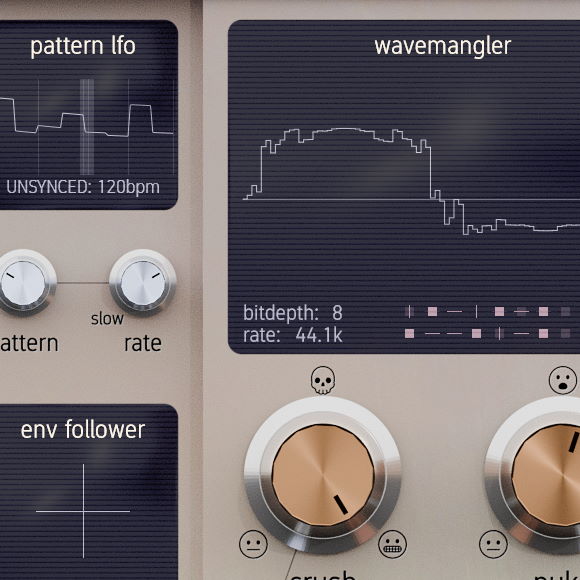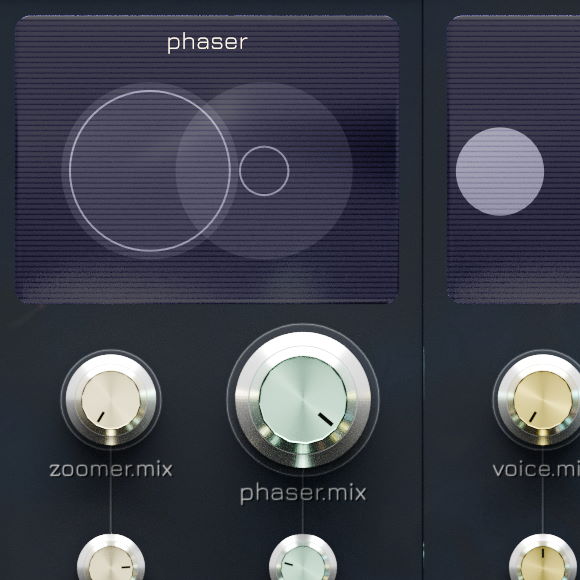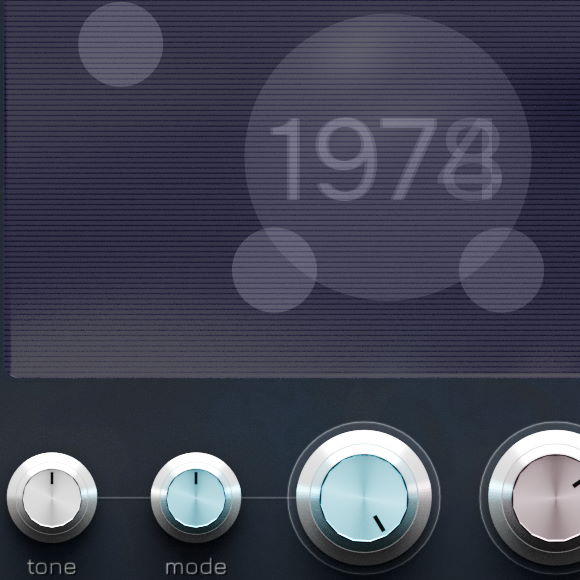remaincalm PARANOIA is an extreme modulated distortion effect, inspired by the sounds of industrial music and chiptune gear.

This effect processor is a massively expanded, ground-up rewrite of an effect published for the Cockos Reaper effect platform in 2008.
PARANOIA is capable of producing extremely distorted sounds. Watch your levels!
Quickstart Guide
The red dials are analog-style gain/crunch stages. The blue dials are filters. The gold dials are extreme waveshaping.
For traditional crunch sounds: start with the 'drive' (valve distortion) and 'intensity' dials (multiband preamp distortion and wavemangler depth). Adjust 'focus' (pre-valve EQ) and filters to taste.
The 'nuke' dial is for wrecking your sounds. It is interactive with 'intensity', 'pre.gain' and 'speaker'.
The white dials are a modulation bus. On most presets, the envelope follower is on by default - dial it to 0 if you only want the LFO active.
The 'drum-real', 'drive' and 'subtle' presets are a good place to start.
Registration
Click the key icon (top-left) and paste in the entire registration code you received via email. By default, your name will be shown on the plugin screen. This can be disabled in the settings.
Contact support@remaincalm.org if you run into any issues.
If unregistered, the plugin will not save any settings or presets, and a weird noise will interrupt playback from time to time.
We've chosen to use a user-friendly, minimally-intrusive registration system. Please don't distribute registration codes. Thanks.
Signal Chain
PARANOIA contains a number of highly-interactive processors. The following diagram is a simplified version of the signal-flow:
A built-in modulator and envelope follower allows for complex time-varying distortion.
Details
The signal passes through a modelled waveshaper and gate, a complex sample crusher and bit-manipulator, an "analog"-style overdrive and speaker simulator, a lowpass and highpass filter, and a final dynamics stage.
A modulation section feeds control signals from a complex LFO (tempo- or session-synced) and envelope follower to key controls.
There is no "full bypass" mode - even with everything off, some processing is occurring.
Controls
Wavemangler Section
Aggressive waveshaper, modelled as a preamp stage, downsampler, bit-depth reducer, and a crossfaded pair of bit-corruptors. Can generate a lot of treble - use the filters to manage harshness.
- intensityControls the intensity of a 'preamp' waveshaping stage, overall tone, and depth of bitcrusher processing. With crush and nuke at zero, this acts as a complex analog-style waveshaper. Settings around the middle (the default) emphasize bass/mids.
- crush Resampler/bitcrusher. Right-side is more extreme and has darker tone and different frequency scaling. Sweeps through 12bit 44100Hz - 441Hz - 44100Hz 8bit.
- crush.modModulation destination. Controls the amount of modulation applied to the 'crush' parameter.
- nuke Bitmangler, crossfades between different bit manipulation patterns, increasingly destructive towards the right. Interactive w/ crush controls. Shift-drag to snap to single pattern.
- nuke.modModulation destination. Controls the amount of modulation applied to the 'nuke' parameter.
Overdrive Section
Warm analog-style dynamic waveshaping. Distortion is frequency-dependent and time-varying. Use the mod controls with the envelope follower to dial in 'amp sag'. Click the screen to toggle an FM-style 'warp' mode.
- drive Valve-style dynamic asymmetric overdrive, with varying behaviour across the dial range. Use the pre- and post-gain controls for extra level.
- drive.mod Modulation destination. Controls the amount of modulation applied to the 'drive' parameter. Useful for dialing in 'amp sag'
- focus Pre-drive 'tonestack' EQ, sweeps through multiple curves to enhance kick (mid-left), snare (middle) and guitar (right). Frequency curves are shown on the overdrive screen.
- speaker Sweeps through algorithmic speaker sims. For guitar, set 'focus' to 50-90 and 'filter' to 60-80. Sounds best with your favourite IR or roomverb. Frequency curves are shown on the overdrive screen.
Filter Section
Variable-shape low and high filters for controlling tone, plus soft-clip ('ouch') and limit indicators for the dynamics processor at the end of the processing chain.
- bass Single-knob resonant high-pass filter, with varying resonance across the filter range. There is no 'off' position - right-most setting is a 20Hz high-pass.
- bass.modModulation destination. Controls the amount of modulation applied to the 'bass' parameter.
- filter Single-knob resonant low-pass filter, with varying resonance across the filter range. There is no 'off' position - right-most setting is a rolloff starting around 15kHz.
- filter.modModulation destination. Controls the amount of modulation applied to the 'filter' parameter.
- squishy Models low-power, toy-grade amplifier circuits, reducing treble as transients increase. Non-linear and interactive with gain and nuke controls.
Modulation Section
Wavetable LFO modulation source for 'mod' controls. Click the screen to toggle host sync/free mode.
- pattern Modulation source. Sweeps between different LFO/sequencer patterns. Full left or right settings disable the LFO. Shift-drag to snap to individual patterns.
- rate Modulation source. LFO/sequencer rate. Click the screen to toggle free/host-sync mode.
Envelope Follower Section
Envelope follower modulation source for 'mod' controls.
- sense Modulation source. Controls the level and sensitivity of the envelope follower. Left-most setting disables the envelope follower.
- releaseModulation source. Controls the decay time of the envelope follower.
Gate Section
Gate, optimized for extreme gating of percussive sounds, although also useful for guitar. Use this in conjunction with dry mix to blend the distorted attack of drum sounds with clean dry tone, and crank the post gain controls to slam the output limiter.
- gateControls threshold and intensity of the gate. Interactive with release time.
- releaseControls release time of the gate.
Output Section
Controls pre/post-gain and clean mix. Pushing output well above 0dBfs will run the signal through a two-band compressor/clipper.
- dry.gain Allows some clean signal through, past the waveshapers and filter. Not phase-corrected - phasing may result. The dry signal also hits the output compressor.
- pre.gain Controls gain into the waveshapers, limited by a soft-clipper. Low levels can interact with the Nuke knob in interesting ways. High levels act like a heavy distortion effect.
- post.gain Controls gain after the waveshaper, but before an always-on frequency-sensitive compressor and soft-clipper. Gain is approximate; compressor level-compensation becomes more aggressive at higher settings.
Settings
Click the gear icon to open a settings screen.
Presets
Click the star icon to try out some presets.
Bug Reports
Please email support@remaincalm.org
Legal
Use of this software is subject to our Terms and Conditions and End User License Agreement.



